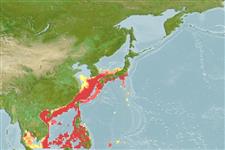Common names from other countries
Environment: milieu / climate zone / depth range / distribution range
Ecología
; rango de profundidad 49 - 314 m (Ref. 4), usually 100 - 250 m (Ref. 4). Tropical; 14°C - 24°C (Ref. 112711), preferred 24°C (Ref. 107945); 38°N - 6°N, 99°E - 142°E (Ref. 4)
Distribución
Países | Áreas FAO | Ecosistemas | Ocurrencias, apariciones | Introducciones
Western Pacific.
Length at first maturity / Tamaño / Peso / Age
Maturity: Lm ? range ? - ? cm Max length : 23.0 cm TL macho / no sexado; (Ref. 4)
It has a maximum total length of 23 cm; and a carapace length of 4 to 7.6 cm (male) and 4 to 8 cm (female), 6 to 8 cm (ovigerous female) (Ref. 4).
Life cycle and mating behavior
Madurez | Reproducción | Puesta | Huevos | Fecundidad | Larva
Members of the order Decapoda are mostly gonochoric. Mating behavior: Precopulatory courtship ritual is common (through olfactory and tactile cues); usually indirect sperm transfer.
Holthuis, L.B. 1991. (Ref. 4)
IUCN Red List Status (Ref. 130435: Version 2024-1)
CITES status (Ref. 108899)
Not Evaluated
Not Evaluated
Human uses
Pesquerías: comercial
FAO - pesquerías: landings | FishSource | Sea Around Us
Herramientas
Más información
Age/Size
Crecimiento
Length-weight
Length-length
Morfología
Larva
Abundancia
Fuentes de Internet
Estimates based on models
Preferred temperature
(Ref.
115969): 17.5 - 26.7, mean 21.1 (based on 214 cells).
Vulnerability
Low vulnerability (13 of 100).
